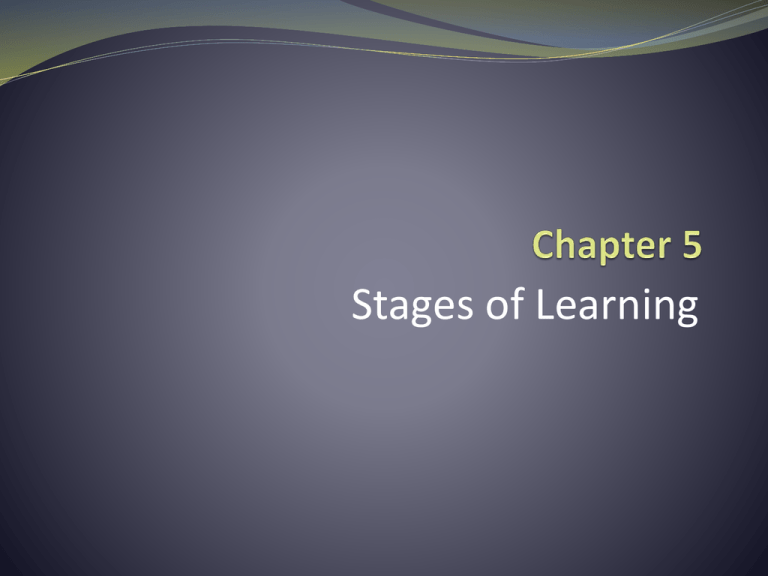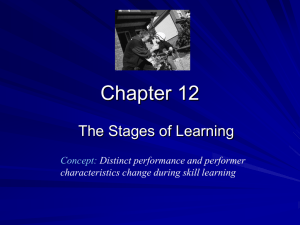Coker2e_Ch05
advertisement

Stages of Learning Things to Consider Regarding the Stages of Learning Transitions between learning stages cannot be clearly delineated. One stage blends into the next. A learner can be in different stages for learning different skills. Stages of learning are not dependent on age. Your Perspective Imagine that you and your roommate are trying to learn a new skill together, and you are at a more advanced stage of learning. What can you do to continue learning while also helping your roommate not to be discouraged? How would you feel if the situation was reversed, and your roommate was more advanced than you? Models of Stages of Learning Fitts and Posner’s three-stage model Gentile’s two-stage model Fitts and Posner’s Three-Stage Model of Learning Learner at the Cognitive Stage Introduced to a new motor skill Develops an understanding of the movement’s requirements Attempts numerous techniques and strategies; a trial-and-error approach Reformulates past movement experiences in an effort to solve the current movement problem Needs guidance to detect and correct errors Learner at the Associative Stage Is committed to refining one particular movement pattern Performs more consistently, with fewer errors Is better at detecting errors and developing strategies to eliminate them Needs constructive practice experiences and effective feedback from practitioner Learner at the Autonomous Stage Can perform a skill proficiently Can perform multiple tasks simultaneously Performs consistently and confidently, with few errors Can detect and correct those errors that are made May become discouraged and unmotivated if proficiency comes slowly Practitioner serves as motivator Gentile’s Two-Stage Model of Learning Getting the Idea of the Movement Learner’s goal: Develop an understanding of movement requirements and the environment in which task is to be performed Organize a corresponding movement Instruction and practice should facilitate the development of a basic movement pattern. Fixation/Diversification Stage Learner’s goal: Refinement of the skill Fixation: Closed skills Example: Performing on a balance beam Diversification: Open skills Closed skills with inter-trial variability Example: Shooting a hockey puck from various angles and positions; golf putting Inferring Progress Indicators That Learning Has Occurred Movement pattern Attention Knowledge and memory Error detection and correction Self-confidence Improvements in Movement Pattern Increase in coordination and control More fluid muscle activity More efficient energy expenditure Increased consistency Freezing and Freeing the Degrees of Freedom Paying Attention Attention to skill execution: As skill proficiency develops, the need to attend consciously to each aspect of the movement decreases—and performance becomes virtually automatic. Allocation of visual attention: Skilled performers direct attention to relevant areas. Beginners have difficulty discriminating between relevant and irrelevant cues. Measuring Progress Performance curves: Negatively accelerating curve Positively accelerating curve Linear curve S-shaped curve Retention tests Transfer tests Types of Performance Curves Limitations of Performance Curves Represent temporary effects and cannot establish relative permanence. Constructed from measurements that are often obtained by calculating the mean of several trials. Each trial could be very different. Performance Plateaus Period of time during the learning process in which no obvious changes in performance occur. May be a transitional period in the learning process. Not necessarily an indication that learner has stopped learning. Possible reasons: Fatigue, anxiety, lack of motivation Limitations in type of performance measurement being used Your Perspective If and when you hit a plateau in your ability to learn a new skill, how do you handle it? What do you do to overcome anxiety or gain new motivation? How would you help someone else overcome his/her performance plateau?







